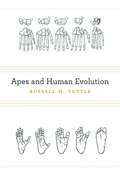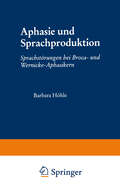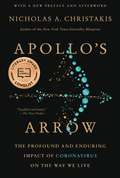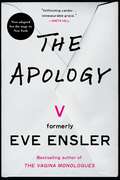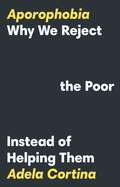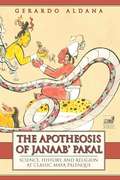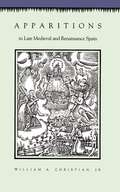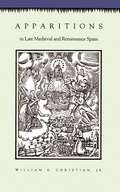- Table View
- List View
Apartheid on a Black Isle: Removal and Resistance in Alexandra, South Africa
by D. CurryIn this single square mile hemmed in by White areas, residents engaged in what is arguably the most multi-faceted, inventive, and versatile strategy of resistance during the 1970s. Apartheid on a Black Isle brings to the fore the definitive but underappreciated role that Alexandra played in advancing human rights. Using their manufactured space, Alexandrans revolutionized the South African freedom struggle by fertilizing the underground movement, by joining in solidarity with Soweto during the student uprising and by finding unique ways to grieve. This book explores and introduces ordinary Alexandrans whose narratives challenged preconceived notions of resistance, identity, gender and space.
Apartheid Vertigo: The Rise in Discrimination Against Africans in South Africa
by David M. MatsinheApartheid vertigo, the dizzying sensation following prolonged oppression and delusions of skin colour, is the focus of this book. For centuries, the colour-code shaped state and national ideals, created social and emotional distances between social groups, permeated public and private spheres, and dehumanized Africans of all nationalities in South Africa. Two decades after the demise of official apartheid, despite four successive black governments, apartheid vertigo still distorts South Africa's postcolonial reality. The colour-code endures, but now in postcolonial masks. Political freedom notwithstanding, vast sections of the black citizenry have adopted and adapted the code to fit the new reality. This vertiginous reality is manifest in the neo-apartheid ideology of Makwerekwere - the postcolonial colour-code mobilized to distinguish black outsiders from black insiders. Apartheid vertigo ranges from negative sentiments to outright violence against black outsiders, including insults, humiliations, extortions, searches, arrests, detentions, deportations, tortures, rapes, beatings, and killings. Ironically, the victims are not only the outsiders against whom the code is mobilized but also the insiders who mobilize it. Drawing on evidence from interviews, observation, press articles, reports, research monographs, and history, this book unravels the synergies of history, migration, nationalism, black group relations, and violence in South Africa, deconstructing the idea of visible differences between black nationals and black foreign nationals. The book demonstrates that in South Africa, violence always lurks on the surface of everyday life with the potential to burst through the fragile limits set upon it and possibly escalate to ethnic cleansing.
Apartheid Vertigo: The Rise in Discrimination Against Africans in South Africa
by David M. MatsinheApartheid vertigo, the dizzying sensation following prolonged oppression and delusions of skin colour, is the focus of this book. For centuries, the colour-code shaped state and national ideals, created social and emotional distances between social groups, permeated public and private spheres, and dehumanized Africans of all nationalities in South Africa. Two decades after the demise of official apartheid, despite four successive black governments, apartheid vertigo still distorts South Africa's postcolonial reality. The colour-code endures, but now in postcolonial masks. Political freedom notwithstanding, vast sections of the black citizenry have adopted and adapted the code to fit the new reality. This vertiginous reality is manifest in the neo-apartheid ideology of Makwerekwere - the postcolonial colour-code mobilized to distinguish black outsiders from black insiders. Apartheid vertigo ranges from negative sentiments to outright violence against black outsiders, including insults, humiliations, extortions, searches, arrests, detentions, deportations, tortures, rapes, beatings, and killings. Ironically, the victims are not only the outsiders against whom the code is mobilized but also the insiders who mobilize it. Drawing on evidence from interviews, observation, press articles, reports, research monographs, and history, this book unravels the synergies of history, migration, nationalism, black group relations, and violence in South Africa, deconstructing the idea of visible differences between black nationals and black foreign nationals. The book demonstrates that in South Africa, violence always lurks on the surface of everyday life with the potential to burst through the fragile limits set upon it and possibly escalate to ethnic cleansing.
Apartment Called Freedom
by AlgosaibiFirst published in 1996. Routledge is an imprint of Taylor & Francis, an informa company.
Apartment Called Freedom
by AlgosaibiFirst published in 1996. Routledge is an imprint of Taylor & Francis, an informa company.
APCC Special Report: Strukturen für ein klimafreundliches Leben
by Christoph Görg Verena Madner Andreas Muhar Andreas Novy Alfred Posch Karl W. Steininger Ernest AignerDie Klimakrise betrifft uns alle - Doch wie kann ein klimafreundliches Leben für alle erreicht werden? Zahlreiche wissenschaftliche Sachstandsberichte bestätigen schon lange den umfassenden Handlungsbedarf, um die Klimaziele zu erreichen. Dieser betrifft alle Lebensbereiche: von Arbeit und Pflege über Wohnen bis zu Mobilität, Ernährung und Freizeit. Doch wie verwirklicht man solch eine Transformation? Der Bericht unterstreicht, dass die Möglichkeiten, klimafreundlich zu leben, wesentlich durch Strukturen vorgegeben ist. Die vorherrschenden Appelle an das verantwortungsbewusste individuelle Verhalten Einzelner und Aufrufe zu nachhaltigem Konsum werden in ihren Wirkungen überschätzt. Entsprechend ist die Kernbotschaft des Berichts, die gemeinsame Gestaltung von Strukturen für ein klimafreundliches Leben ins Zentrum der Klimapolitik zu stellen. Daher gibt das Buch Antworten auf folgende Fragen: Wie können Rahmenbedingungen so gestaltet werden, dass ein klimafreundliches Leben für jeden selbstverständlich oder zumindest erleichtert wird?Welchen Beitrag können die verschiedenen gesellschaftlichen Akteure leisten? Was bedeutet dies für Recht und Governance, die Wirtschaft, Globalisierung und das Finanzsystem?Können Medien einen Beitrag dazu leisten? Welche Rolle haben Ungleichheit, soziale Sicherung und Raumplanung und welche Infrastrukturen sind notwendig? Dieses Open Access Buch ist das Ergebnis eines umfassenden wissenschaftlichen Erstellungsprozesses, der sich an der Arbeitsweise des Weltklimarates IPCC orientierte: mehr als 80 Autor_innen analysierten die aktuelle wissenschaftliche Literatur zur Gestaltung von Strukturen für ein klimafreundliches Leben. Dazu wurden über 2000 Literaturquellen ausgewertet. Zur Absicherung der Qualität wurden die Ergebnisse der Autor_innen von in etwa 180 Expert_innen und circa 100 Stakeholdern in mehreren Runden begutachtet. Der innovative Zugang und die bisher wenig aufgegriffenen Themenfelder machen das Buch zu einem Standardwerk für die Klimaforschung im deutschsprachigen Raum.
Apes and Human Evolution
by Russell H. TuttleIn this masterwork, Russell H. Tuttle synthesizes a vast research literature in primate evolution and behavior to explain how apes and humans evolved in relation to one another, and why humans became a bipedal, tool-making, culture-inventing species distinct from other hominoids. Along the way, he refutes the theory that men are essentially killer apes--sophisticated but instinctively aggressive, destructive beings. Situating humans in a broad context, Tuttle musters evidence from morphology and recent fossil discoveries to reveal what early primates ate, where they slept, how they learned to walk upright, how brain and hand anatomy evolved simultaneously, and what else happened evolutionarily to cause humans to diverge from their closest relatives. Despite our genomic similarities with bonobos, chimpanzees, and gorillas, humans are unique among primates in occupying a symbolic niche of values and beliefs based on symbolically mediated cognitive processes. Although apes exhibit behaviors that strongly suggest they can think, salient elements of human culture--speech, mating proscriptions, kinship structures, and moral codes--are symbolic systems that are not manifest among apes. This encylopedic volume is both a milestone in primatological research and a critique of what is known and yet to be discovered about human and ape potential.
Apes and Human Evolution
by Russell H. TuttleIn this masterwork, Russell H. Tuttle synthesizes a vast research literature in primate evolution and behavior to explain how apes and humans evolved in relation to one another, and why humans became a bipedal, tool-making, culture-inventing species distinct from other hominoids. Along the way, he refutes the theory that men are essentially killer apes--sophisticated but instinctively aggressive, destructive beings. Situating humans in a broad context, Tuttle musters evidence from morphology and recent fossil discoveries to reveal what early primates ate, where they slept, how they learned to walk upright, how brain and hand anatomy evolved simultaneously, and what else happened evolutionarily to cause humans to diverge from their closest relatives. Despite our genomic similarities with bonobos, chimpanzees, and gorillas, humans are unique among primates in occupying a symbolic niche of values and beliefs based on symbolically mediated cognitive processes. Although apes exhibit behaviors that strongly suggest they can think, salient elements of human culture--speech, mating proscriptions, kinship structures, and moral codes--are symbolic systems that are not manifest among apes. This encylopedic volume is both a milestone in primatological research and a critique of what is known and yet to be discovered about human and ape potential.
Aphasie und Natürlichkeit: Abbauhierarchien im Bereich der Grammatik (Psycholinguistische Studien)
by Barbara SeewaldSprachliche Fehlbildungen, wie sie bei Aphasien auftreten, weisen bei genauer Betrachtung eine beeindruckende Regelmäßigkeit auf. Hinter diesen Regelmäßigkeiten wird ein Prinzip vermutet, das nicht nur sprachpathologische Phänomene steuert, sondern für den gesamten hochsystematischen Aufbau von Sprache und anderen kognitiven Fähigkeiten verantwortlich ist. An konkreten Falluntersuchungen werden unter Anwendung des Natürlichkeitsprinzips Abbauhierarchien im Bereich der Grammatik dargestellt. Neben den theoretischen Grundlagen bietet das Buch zahlreiche Beispiele agrammatischer Sprache sowie Vorschläge für eine mögliche Anwendung in Diagnostik und Therapie.
Aphasie und Sprachproduktion: Sprachstörungen bei Broca- und Wernicke-Aphasikern (Psycholinguistische Studien)
by Barbara HöhleDie Analyse zu grammatischen Besonderheiten im sprachlichen Verhalten aphasischer Patienten bildet seit einigen Jahren den Schwerpunkt der kognitionswissenschaftlich orientierten Aphasieforschung. In diesem Band werden vor allem die Erscheinungsformen und die möglichen Ursachen morpho-syntaktischer Beeinträchtigungen in der Sprachproduktion von Aphasikern thematisiert. Den Kern der Arbeit bildet eine breite empirische Untersuchung an deutschsprachigen Broca- und Wernicke-Aphasikern, in der Unterschiede und Gemeinsamkeiten bei der Produktion flektierter Wortformen bei diesen Patientengruppen experimentell überprüft wurden. Die Ergebnisse zeigen erstaunlich gute und parallele Leistungen beider Patientengruppen, die gegen die Annahme eines generellen syntaktischen Defizits im Agrammatismus sprechen. Die Relevanz dieser Ergebnisse für gängige Erklärungsansätze zum Agrammatismus und Paragrammatismus wird abschließend diskutiert.
APM Salary and Market Trends Survey 2021
by Association for Project ManagementOur Salary and Market Trends Survey took place in November 2020 against a backdrop that few could have predicted 12 months before. Working with YouGov, the survey captured not only the facts and figures shaping the project profession, but also created a snapshot of a profession dealing with the impact of a global pandemic. We are able to better understand how the longer-term trends of a younger, more diverse profession were combining with the short-term shock brought about by coronavirus. The result is a useful picture of a profession holding steady in the face of some serious adversity. For most the impact has not been as bad as some may have feared and that the profession as a whole remains optimistic about its ability to navigate a difficult time. While expectations for growth may have been tempered, a strong sense of resilience and steadfastness shines through the 2,626 responses. Please note, whole numbers are used for the report, so some figures may not add up to 100 per cent due to rounding. The median has been used as the average for salaries, unless stated.
Apocalypse in Contemporary Japanese Science Fiction
by M. TanakaStarting with the history of apocalyptic tradition in the West and focusing on modern Japanese apocalyptic science fiction in manga, anime, and novels, Motoko Tanaka shows how science fiction reflected and coped with the devastation in Japanese national identity after 1945.
The Apocalypse Is Everywhere: A Popular History of America's Favorite Nightmare (Non-ser.)
by Anne RehillThis wide-ranging exploration of the apocalypse in Western culture seeks to understand how we have come to be so preoccupied with spectacular visions of our own annihilation—offering abundant examples of the changing nature of our imagined destruction, and predisposing readers to discover many more all around them.The Apocalypse Is Everywhere: A Popular History of America's Favorite Nightmare explores why apocalyptic thinking exists, how it has been manifested in Western culture through the ages, and how it has woven itself so thoroughly into our popular culture today.Beginning with contemporary apocalyptic expressions, the book demonstrates how surprisingly widespread they are. It then discusses how we inherited them and where they arose. Author Annie Rehill surveys the ancient belief systems from which Christianity evolved, including ancient Judaism and other faiths. She explores the vision outlined in the Book of Revelation and traces the apocalyptic thread through the Middle Ages, across the Reformation and Enlightenment, and to the Americas. Finally, to prove that the Apocalypse is indeed everywhere, Rehill returns to the present to consider the idea of apocalypse as it occurs in movies, books, comics and graphic novels, games, music, and art, as well asin televangelism and even presidential speeches. Her fascinating scholarship will surely have readers looking about them with new eyes.
Apocalyptic Geographies: Religion, Media, and the American Landscape
by Jerome TharaudHow nineteenth-century Protestant evangelicals used print and visual media to shape American cultureIn nineteenth-century America, "apocalypse" referred not to the end of the world but to sacred revelation, and "geography" meant both the physical landscape and its representation in printed maps, atlases, and pictures. In Apocalyptic Geographies, Jerome Tharaud explores how white Protestant evangelicals used print and visual media to present the antebellum landscape as a “sacred space” of spiritual pilgrimage, and how devotional literature influenced secular society in important and surprising ways.Reading across genres and media—including religious tracts and landscape paintings, domestic fiction and missionary memoirs, slave narratives and moving panoramas—Apocalyptic Geographies illuminates intersections of popular culture, the physical spaces of an expanding and urbanizing nation, and the spiritual narratives that ordinary Americans used to orient their lives. Placing works of literature and visual art—from Thomas Cole’s The Oxbow to Harriet Beecher Stowe’s Uncle Tom’s Cabin and Henry David Thoreau’s Walden—into new contexts, Tharaud traces the rise of evangelical media, the controversy and backlash it engendered, and the role it played in shaping American modernity.
Apocalyptic Geographies: Religion, Media, and the American Landscape
by Jerome TharaudHow nineteenth-century Protestant evangelicals used print and visual media to shape American cultureIn nineteenth-century America, "apocalypse" referred not to the end of the world but to sacred revelation, and "geography" meant both the physical landscape and its representation in printed maps, atlases, and pictures. In Apocalyptic Geographies, Jerome Tharaud explores how white Protestant evangelicals used print and visual media to present the antebellum landscape as a “sacred space” of spiritual pilgrimage, and how devotional literature influenced secular society in important and surprising ways.Reading across genres and media—including religious tracts and landscape paintings, domestic fiction and missionary memoirs, slave narratives and moving panoramas—Apocalyptic Geographies illuminates intersections of popular culture, the physical spaces of an expanding and urbanizing nation, and the spiritual narratives that ordinary Americans used to orient their lives. Placing works of literature and visual art—from Thomas Cole’s The Oxbow to Harriet Beecher Stowe’s Uncle Tom’s Cabin and Henry David Thoreau’s Walden—into new contexts, Tharaud traces the rise of evangelical media, the controversy and backlash it engendered, and the role it played in shaping American modernity.
Apollo's Arrow: The Profound and Enduring Impact of Coronavirus on the Way We Live
by Nicholas A. ChristakisA piercing and scientifically grounded look at the emergence of the coronavirus pandemic and how it will change the way we live — "this year's must-must-read." (Daniel Gilbert) Apollo's Arrow offers a riveting account of the impact of the coronavirus pandemic as it swept through American society in 2020, and of how the recovery will unfold in the coming years. Drawing on momentous (yet dimly remembered) historical epidemics, contemporary analyses, and cutting-edge research from a range of scientific disciplines, bestselling author, physician, sociologist, and public health expert Nicholas A. Christakis explores what it means to live in a time of plague — an experience that is paradoxically uncommon to the vast majority of humans who are alive, yet deeply fundamental to our species. Unleashing new divisions in our society as well as opportunities for cooperation, this 21st-century pandemic has upended our lives in ways that will test, but not vanquish, our already frayed collective culture. Featuring new, provocative arguments and vivid examples ranging across medicine, history, sociology, epidemiology, data science, and genetics, Apollo's Arrow envisions what happens when the great force of a deadly germ meets the enduring reality of our evolved social nature.
Apollo's Arrow: The Profound and Enduring Impact of Coronavirus on the Way We Live
by Nicholas A. ChristakisA piercing and scientifically grounded look at the emergence of the coronavirus pandemic and how it will change the way we live — "excellent and timely." (The New Yorker) Apollo's Arrow offers a riveting account of the impact of the coronavirus pandemic as it swept through American society in 2020, and of how the recovery will unfold in the coming years. Drawing on momentous (yet dimly remembered) historical epidemics, contemporary analyses, and cutting-edge research from a range of scientific disciplines, bestselling author, physician, sociologist, and public health expert Nicholas A. Christakis explores what it means to live in a time of plague — an experience that is paradoxically uncommon to the vast majority of humans who are alive, yet deeply fundamental to our species.Unleashing new divisions in our society as well as opportunities for cooperation, this 21st-century pandemic has upended our lives in ways that will test, but not vanquish, our already frayed collective culture. Featuring new, provocative arguments and vivid examples ranging across medicine, history, sociology, epidemiology, data science, and genetics, Apollo's Arrow envisions what happens when the great force of a deadly germ meets the enduring reality of our evolved social nature.
Apologies and the Legacy of Abuse of Children in 'Care': International Perspectives (Palgrave Studies in the History of Childhood)
by Johanna Sk�ld Shurlee SwainThis book positions inquiries into the historical abuse of children in care within the context of transitional justice. It examines investigation, apology and redress processes across a range of Western nations to trace the growth of the movement, national particularities and the impact of the work on professionals involved.
Apologies to Thucydides: Understanding History as Culture and Vice Versa
by Marshall SahlinsThucydides' classic work on the history of the Peloponnesian War is the root of Western conceptions of history—including the idea that Western history is the foundation of everyone else's. Here, Marshall Sahlins takes on Thucydides and the conceptions of history he wrought with a groundbreaking new book that shows what a difference an anthropological concept of culture can make to the writing of history. Sahlins begins by confronting Thucydides' account of the Peloponnesian War with an analogous "Polynesian War," the fight for the domination of the Fiji Islands (1843-55) between a great sea power (like Athens) and a great land power (like Sparta). Sahlins draws parallels between the conflicts with an eye to their respective systems of power and sovereignty as well as to Thucydides' alternation between individual (Pericles, Themistocles) and collective (the Athenians, the Spartans) actors in the making of history. Characteristic of most histories ever written, this alternation between the agency of "Great Men" and collective entities leads Sahlins to a series of incisive analyses ranging in subject matter from Bobby Thomson's "shot heard round the world" for the 1951 Giants to the history-making of Napoleon and certain divine kings to the brouhaha over Elián Gonzalez. Finally, again departing from Thucydides, Sahlins considers the relationship between cultural order and historical contingency through the recounting of a certain royal assassination that changed the course of Fijian history, a story of fratricide and war worthy of Shakespeare. In this most convincing presentation yet of his influential theory of culture, Sahlins experiments with techniques for mixing rich narrative with cultural explication in the hope of doing justice at once to the actions of persons and the customs of people. And he demonstrates the necessity of taking culture into account in the creation of history—with apologies to Thucydides, who too often did not.
The Apology
by Eve EnslerFrom Eve Ensler, author of one of the most influential works of the twentieth century--The Vagina Monologues--and one of Newsweek's "150 Women Who Changed the World," comes a powerful, life-changing examination of abuse and atonement. Like millions of women, Eve Ensler has been waiting much of her lifetime for an apology. Sexually and physically abused by her father, Eve has struggled her whole life from this betrayal, longing for an honest reckoning from a man who is long dead. After years of work as an anti-violence activist, she decided she would wait no longer; an apology could be imagined, by her, for her, to her. The Apology, written by Eve from her father's point of view in the words she longed to hear, attempts to transform the abuse she suffered with unflinching truthfulness, compassion, and an expansive vision for the future. Through The Apology Eve has set out to provide a new way for herself and a possible road for others, so that survivors of abuse may finally envision how to be free. She grapples with questions she has sought answers to since she first realized the impact of her father's abuse on her life: How do we offer a doorway rather than a locked cell? How do we move from humiliation to revelation, from curtailing behavior to changing it, from condemning perpetrators to calling them to reckoning? What will it take for abusers to genuinely apologize? Remarkable and original, The Apology is an acutely transformational look at how, from the wounds of sexual abuse, we can begin to re-emerge and heal. It is revolutionary, asking everything of each of us: courage, honesty, and forgiveness.
Aporophobia: Why We Reject the Poor Instead of Helping Them
by Professor Adela CortinaWhy “aporophobia”—rejection of the poor—is one of the most serious problems facing the world today, and how we can fight itIn this revelatory book, acclaimed political philosopher Adela Cortina makes an unprecedented assertion: the biggest problem facing the world today is the rejection of poor people. Because we can’t recognize something we can’t name, she proposes the term “aporophobia” for the pervasive exclusion, stigmatization, and humiliation of the poor, which cuts across xenophobia, racism, antisemitism, and other prejudices. Passionate and powerful, Aporophobia examines where this nearly invisible daily attack on poor people comes from, why it is so harmful, and how we can fight it.Aporophobia traces this universal prejudice’s neurological and social origins and its wide-ranging, pernicious consequences, from unnoticed hate crimes to aporophobia’s threat to democracy. It sheds new light on today’s rampant anti-immigrant feeling, which Cortina argues is better understood as aporophobia than xenophobia. We reject migrants not because of their origin, race, or ethnicity but because they seem to bring problems while offering nothing of value. And this is unforgivable in societies that enshrine economic exchange as the supreme value while forgetting that we can’t create communities worth living in without dignity, generosity, and compassion for all. Yet there is hope, and Cortina explains how we can overcome the moral, social, and political disaster of aporophobia through education and democratic institutions, and how poverty itself can be eradicated if we choose.In a world of migrant crises and economic inequality, Aporophobia is essential for understanding and confronting one of the most serious problems of the twenty-first century.
The Apotheosis of Janaab' Pakal: Science, History, and Religion at Classic Maya Palenque (Mesoamerican Worlds)
by Gerardo AldanaThe Apotheosis of Janaab' Pakal takes up anew the riddles within a number of Maya hieroglyphic inscriptions first recognized by Floyd Lounsbury. Gerardo Aldana unpacks these mathematical riddles using an approach grounded in a reading of the texts made possible by recent advances in decipherment. Using a history of science methodology, he expands upon (and sometimes questions) the foundational work of archaeoastronomers. Aldana follows three lines of investigation: a reading of the hieroglyphic inscriptions of the Classic period (a.d. 250-900), mathematical analysis to recover Classic Maya astronomical practice, and a historiography of Maya astronomy. Quoted hieroglyphs appear throughout the text for cross-examination. Aldana reveals the social and political context of Maya astronomy by explicating the science and calendrical calculations found in the tablets of the Temple of Inscriptions and the Cross Group from the city of Palenque. He offers a compelling interpretation of an 819-day count, demonstrating its utility as an astronumerological tool that Maya scribes used to simplify complex calculations. During troubled times in Palenque, Aldana contends, Kan Balam II devised a means to preserve the legitimacy of his ruling dynasty. He celebrated a re-creation of the city as a contemporary analogue of a mythical Creation on three levels: monumental construction for a public audience, artistic patronage for an elite audience, and a secret mathematical astronomical language only for rulers-elect. Discussing all of these efforts, Aldana focuses on the recovery of the secret language and its historical context.
Apparitions in Late Medieval and Renaissance Spain
by William A. ChristianThe description for this book, Apparitions in Late Medieval and Renaissance Spain, will be forthcoming.
Apparitions in Late Medieval and Renaissance Spain (PDF)
by William A. Christian Jr.The description for this book, Apparitions in Late Medieval and Renaissance Spain, will be forthcoming.
The Appeal of Art in Modernity (Classical and Contemporary Social Theory)
by Michael SymondsThis book explores the place of art in the modern world, but instead of asking what art is, it begins with the question of art’s appeal in modernity. Why is the appellation ‘art’ so desired for movies, food, and fashion, for example? Why is there the assumption of esteem when someone calls themselves an ‘artist’? On the other hand, why is modern art so often seen as, at best, difficult and, at worst, not, in fact, art? Engaging with a broad range of theory, the author draws on the thought of Max Weber to offer an account of art’s widespread appeal in terms of its constituting a self-contained value-sphere of meaning, which provides a feeling of tremendous salvation from the senseless routines of modern life. In this way, major theories on aesthetics in philosophy and sociology – including those of Kant, Hegel, Adorno and Bourdieu – are critically recast and incorporated into an overall explanation, and fundamental questions concerning the relation of art to politics and ethics are given innovative answers. A fresh examination of the development of the aesthetic sphere that shows how art came to be regarded as one of the last bastions of freedom and the highest human achievement, and, also, how it became increasingly isolated from the rest of society, The Appeal of Art in Modernity will appeal to scholars of philosophy, social theory, and sociology with interests in art, modernity, and Weber.




